The Sensation felt by our ears is called sound. It is a form of energy. Without vibration, it can’t be produced. is always being produced by vibrations. For example – Rubber stretching, Sound of a Guitar.
The to-and-fro motion of a body is called vibration.
Production of Sound: – Vibration
- Vibrations and oscillation are Duale thing
- Vibrations occur at high frequencies.
- The oscillation has a very low frequency.
- Therefore, Oscillation cannot produce sound. produced by vibration by vibrating body
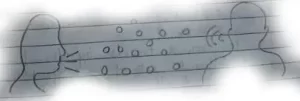
When a sound is produced, it travels through the medium. In the above example, our medium is Air. Air has air particles.
Propagation of Sound Waves
During the transformation of energy between air particles, some amount of energy loss takes place.
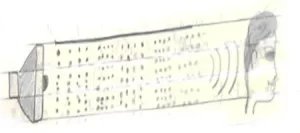
Rarefaction (No. of air particles less), Compression (No. of air particles more)
It means Air particles show to-and-fro motion. It transfers K.E. from one set of particles to another set of particles and reverses back. The moment sound comes out from the mouth, this energy is transferred to the first set of particles (S.E. – K.E. ). Particles start moving in the same direction with greater velocity. This one set of particles collides with the second set of particles, the Second set of particles collides with the third set, and so on. Your sound travels by transferring energy to different sets of our particles. Thus, finally reaching the eardrums.
Must Read: Power and Speed Rule Questions: Science
This causes vibrating of eardrums to how the other person can listen to the sound. A person standing near the speaker gets more sound energy. Therefore, gets the sound more clearly. While the person standing away from the speaker gets less sound and hence its clarity decreases.
Sound propagates through vibration. Air particles perform to and fro motion. While propagation of sound two regions are formed between particles of the medium.
- Compression – High-density, high-pressure
- Rare fraction – Low density, low pressure.
Medium for sound propagation: – Air, Solid, Liquid
Ques: In which medium sound propagation is faster?
Answer – Solids > Liquids > Gases > Vacuum
The denser the particles of the medium, the faster will be the transfer of energy.
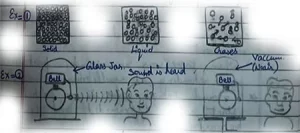
- Air is present in the Sound glass Jar sound of the bell is heard.
- Vacuum in a glass jar Sand of the bell is not heard
Most Important: Defense Technology
Characteristics of Sound: Amplitude
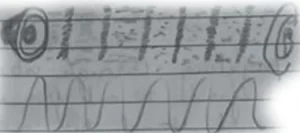
Every sound wave can be depicted as a graphical representation. It always travels in waves –
- Longitudinal Waves – where energy transfer (direction) is always parallel or antiparallel to the direction of propagation of particles.
- Pressure Waves = Repetition of pressure (high to low)
Compressor – Rarefaction – Compressor – Rarefaction
Every point on the sound wave is a particle movement. When there was no sound, particles stood at an equilibrium – position. Sound energy Came in particles starting going forward and coming backward. Waves tell the displacement of the particles.
- Y-axis – displacement of articles.
- X-axis – Equilibrium position
- Maximum displacement = peak points of waves = Amplitude
The maximum displacement of the medium particles from the equilibrium position or the mean position.
Amplitude = Equilibrium to maximum per
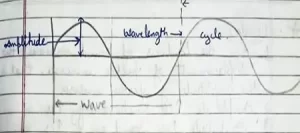
- 1 to and fro motion is 1 wave
- 1 wave = 1 oscillation
Characteristics of Sound: – Frequently
Frequency = Number of complete wave cycles produced in one second is called the frequency of the Waves. The number of oscillations per second more Frequency more > Number of oscillations per second less Frequency less.
- Frequency = 1/Time period
- F = 1/10
Question: If a particle is oscillating for 10 seconds. what is the frequency?
Answer: F = 1/10 Hertz (unit of frequency)
Also, Read this – Chemical Changes ( रासायनिक परिवर्तन )
Loudness
when the loudness of sound increases, the displacement of the speaker increases, that is the amplitude of the speaker increases. Amplitude increase Kinetic energy also increases and Amplitude increases sound energy also increases. Loudness is the measure of sound energy reading in the ear per second.
Loudness ∝ (Amplitude)2
It is measured in Decibel (dB). Above 80 dB sounds become physically painful fall Noise.
Pitch

When a Frequency of a wave is more it is called high pitch sound and when a frequency of a wave is less it is called low pitch sound.
Characteristics of Sound: Wavelength and Velocity
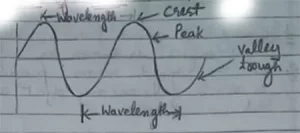
- Wavelength length of one wave
- I Wave = 1 crest + 1 trough
- Wavelength is denoted by lambda (λ).
- The distance between two successive peaks or valleys is called wavelength.
- Distance between two successive crests or two successive troughs X SI = m
Wave velocity = Distance covered by the wave per unit of time
Speed = distance/time
V = λv ( v=1/t)
Speed = wavelength x frequency
- V= Wavelength Velocity
- λ = Wavelength.
- V = frequency
Reflection of Sound
The bouncing of sound from a material surface (hard surface) is known as the reflection of sound. When the sound waves produced from a source fall on any object and reflect back.
Reflection of Sound Laws
The laws of reflection of light are equivalent to the law of reflection of sound.
- The incident sound wave, the reflected sound wave, and the normal at the point of incidence, all lie the same plane.
- The angle of reflection of sound is always equal to the angle of incidence sound.
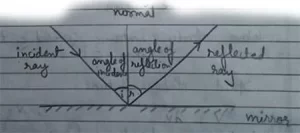
Whatever we speak, it persists in our brain for 0.1 seconds. You can hear whatever you speak.
Echo
The repetition of sound caused by the reflection of the Sound wave is called Echo. The minimum time interval should be 0.1 sec to hear an echo.
Formula for Echo
S = 2D/t
- D = Distance between the source and the reflecting Surface
- t = Time interval
- S = Speed
Imp: Separation of Substances Mcq Questions
Multiple Echoes: – Reverberation
The persistence of sound due to repeated reflections is Called Reverberation. Echoes heard more than once due to successive or multiple reflections.
Applications: – Loudspeaker, Stethoscope, Ceiling of Concert Hall
Condition To Hear an Echo
Question: – Calculate the minimum distance required to produce an Echo.
Ans. t = 0.15 sec.
S = 2 D/t
D = S x t/2
= (344 m/sec. X 0.1)/2
= 17.2 meters
- Source = Reflecting Surface
- [speed of Average sound wave = 344 m/sec]
Distance from Source to the reflecting surface is 17.2 meters or we can say 34.4m because always takes double the distance (2D).
The minimum distance between the blue source sound production and the reflecting body should be 17.2 m. The minimum time should be 0.1 sec. The intensity of sound should be sufficient.
Numerical
Question: – A person clapped his hands near the cliff and heard an echo after 2 sec. What is the distance of the cliff from the person if the speed of sound v is taken as 346 m sec-1?
Answer: – Speed of sound v = 346 m sec-1
Time taken for hearing the echo t = 2 sec
Distance traveled by the sound = v X t
= 346 m sec-1 x 2 sec
= 692 m
In 2 sec. sound has to travel twice the distance between the cliff and the person. Hence, the distance between the cliff and the person = 692 m/2 = 346 m.
Frequency Range of Hearing in Humans: –
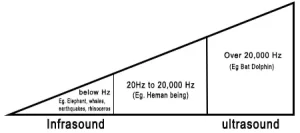
The sound produced in our environment has many different frequencies. It of “all the frequencies cannot be heard by human beings, For example, if the frequency of a sound is less than 20 hertz, it can’t be heard by human beings and if the frequency of a sound is greater than 20000, even then it cannot be heard by human beings, Thus A human ear cannot hear the sound of frequencies less than 20 hertz and more than 20000 hertz.
The human ear can hear frequencies from 20hz to 20000hz is known as the Frequency range of hearing in humans. The sound which we are able to hear is called audible sound.
The sounds of frequencies lower than 20 Hz are known as infrasonic Sounds. it cannot be heard by human beings. It is produced by these objects which vibrate very slowly.
Ultrasound
The sounds having a too high a frequency (greater than 20,000 hertz) that cannot be heard by human beings are called ultrasonic sounds or ultrasounds, For example, a sound of frequency 1,00,000 hertz is an ultrasound. The ultrasound is reflected just like ordinary sound waves and produced echoes.
But the echoes produced by the ultrasound cannot be heard by our ears, they can only be deducted by special equipment. Due to its very high frequency, ultrasound has much greater penetrating power than ordinary sound. It can be used to detect objects under the sea, and organs inside the human body.
Application of Ultrasound
Ultrasound is used in industry for detecting flaws (Cracks, etc.) in metal blocks without damaging them. The flaws like internal cracks, etc. in the metal blocks are detected by using ultrasound. This is based on the fact that an internal crack (or holds etc.) does not allow ultrasound to pass through it. It reflects ultrasound.
It is used to investigate the internal organs of the human body such as lives, gallbladder, pancreas, uterus, Liver, etc. Ultrasound scans are used to monitor the development of the Foetus (unborn baby) inside the mother’s uterus and break kidney stones into fine grains.
it’s used in ‘sonar’ apparatus to measure the depth of the sea and to locate undersea objects like shoals of fish, shipwrecks, submarines, sea rocks, and hidden icebergs in the sea.
SONAR (Sound Navigation and Ranging)
It is an apparatus that is used to find the depth of the sea or to locate underwater things Like shoals, fish, Shipwrecks, and energy submarines.
SONAR apparatus has two parts:
- Transmitter
- Receiver
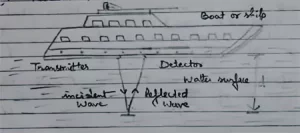
Numericals
Question: – A ship sends out an ultrasound that returns from the seabed and is detected after 3.42 sec. if the speed of ultrasound through Seawater is 1531 m/sec, what is the distance of the seabed from the ship?
Solutions – Griven,
The time between transmission and detection, t=3.42 sec
Speed of ultrasound in seawater V = 1531 m/sec
Distance traveled by the ultrasound = 2 x depth of the sea
= 2d (where d is the depth of the sea)
2 d = speed of sound X time.
= 1531 m/sec. x 3.42 sec
= 5236 m
d = 5236 m/2 = 2618 m
Thus, the distance of the seabed from the ship is 2618 m or 2.62 Km.
Structure of Human Ear: –
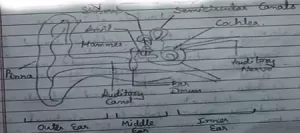
- Outer ear: – Consist of Pinna and ear canal.
- Middle ear: – Consist of eardrum & three bones (hammer, anvil & stirrup)
- Inner ear: – Consists of cochlea & three semi-circular canals.
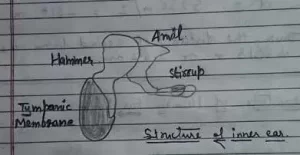
Working:
- Pinna collects sound from the surrounding
- The eardrum vibrates with sound waves.
- Vibrations are amplified by hammer, anvil, and stirrup
- The cochlea converts amplified vibrations into electrical signals
- The auditory nerve transfers electrical signals to the brain and the brain interprets it as a sound.
Important Notes & Test Series: –
- कोशिका विभाजन | समसूत्री व अर्द्धसूत्री विभाजन | Biology : Cell division
- जीवधारियों का वर्गीकरण | Science : Classification of Organisms
- भारतीय संविधान की प्रस्तावना | Preamble of the Constitution | संवैधानिक विकास
- Behavioral Geography MCQ Test for Competitive Exams
- राजस्थान की सिंचाई योजना से सम्बंधित प्रश्नोतरी | Rajasthan Quiz
Please share your feedback about this post via comment, which will help to encourage or improve our future updates. Heartfelt thanks for reading our post, please share it with your friends, Whatsapp group, or another platform. If you want to join our Whatsapp group then message us at 9015746713 Whatsapp number.
Specially thanks to Post Author – Aradhana Jaipur (Rajasthan)
Pingback: Marburg Virus : Symptoms and Treatment | MVD